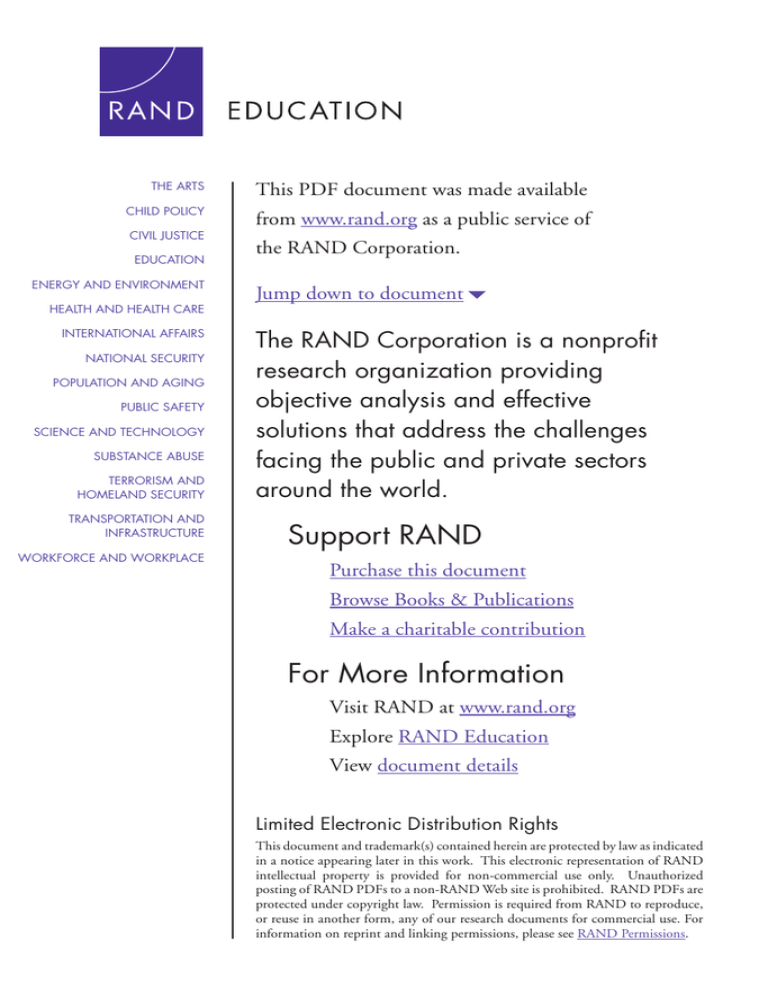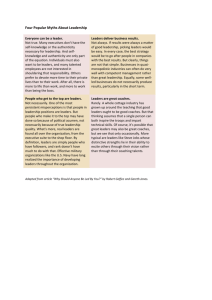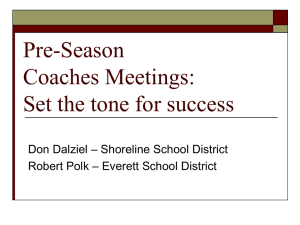6 The RAND Corporation is a nonprofit from
advertisement

THE ARTS This PDF document was made available CHILD POLICY from www.rand.org as a public service of CIVIL JUSTICE EDUCATION ENERGY AND ENVIRONMENT HEALTH AND HEALTH CARE INTERNATIONAL AFFAIRS NATIONAL SECURITY POPULATION AND AGING PUBLIC SAFETY SCIENCE AND TECHNOLOGY SUBSTANCE ABUSE TERRORISM AND HOMELAND SECURITY TRANSPORTATION AND INFRASTRUCTURE WORKFORCE AND WORKPLACE the RAND Corporation. Jump down to document6 The RAND Corporation is a nonprofit research organization providing objective analysis and effective solutions that address the challenges facing the public and private sectors around the world. Support RAND Purchase this document Browse Books & Publications Make a charitable contribution For More Information Visit RAND at www.rand.org Explore RAND Education View document details Limited Electronic Distribution Rights This document and trademark(s) contained herein are protected by law as indicated in a notice appearing later in this work. This electronic representation of RAND intellectual property is provided for non-commercial use only. Unauthorized posting of RAND PDFs to a non-RAND Web site is prohibited. RAND PDFs are protected under copyright law. Permission is required from RAND to reproduce, or reuse in another form, any of our research documents for commercial use. For information on reprint and linking permissions, please see RAND Permissions. This product is part of the RAND Corporation monograph series. RAND monographs present major research findings that address the challenges facing the public and private sectors. All RAND monographs undergo rigorous peer review to ensure high standards for research quality and objectivity. supporting literacy across the sunshine state A Study of Florida Middle School Reading Coaches Julie A. Marsh | Jennifer Sloan McCombs J. R . Lockwood | Fr ancisco Martorell Daniel Gershwin | Scott Naftel Vi-Nhuan Le | Molly Shea Heather Barney | Al Crego Prepared for Carnegie Corporation of New York EDUCAT ION The research described in this report was prepared for the Carnegie Corporation of New York and was conducted by RAND Education, a unit of the RAND Corporation. Library of Congress Cataloging-in-Publication Data Supporting literacy across the sunshine state : a study of Florida middle school reading coaches / Julie A. Marsh ... [et al.]. p. cm. Includes bibliographical references. ISBN 978-0-8330-4509-6 (pbk. : alk. paper) 1. Reading (Middle school)—Florida—Case studies. 2. Reading teachers— In-service training—Florida—Case studies. I. Marsh, Julie A. LB1050.5.S87 2008 428.4'071'2—dc22 2008034441 The RAND Corporation is a nonprofit research organization providing objective analysis and effective solutions that address the challenges facing the public and private sectors around the world. R AND’s publications do not necessarily reflect the opinions of its research clients and sponsors. R® is a registered trademark. Cover design by Peter Soriano © Copyright 2008 RAND Corporation All rights reserved. No part of this book may be reproduced in any form by any electronic or mechanical means (including photocopying, recording, or information storage and retrieval) without permission in writing from RAND. Published 2008 by the RAND Corporation 1776 Main Street, P.O. Box 2138, Santa Monica, CA 90407-2138 1200 South Hayes Street, Arlington, VA 22202-5050 4570 Fifth Avenue, Suite 600, Pittsburgh, PA 15213-2665 RAND URL: http://www.rand.org To order RAND documents or to obtain additional information, contact Distribution Services: Telephone: (310) 451-7002; Fax: (310) 451-6915; Email: order@rand.org Summary While the literacy skills needed to engage in the economy and public life have grown, the literacy skills of many adolescents remain low—in 2007, only 31 percent of eighth grade students performed at or above the proficient level on the National Assessment of Educational Progress (NAEP), a national assessment that informs the public about the academic achievement of elementary and secondary students in the United States. One popular approach to improving student literacy is using school-based reading coaches—specially trained master teachers who provide leadership for the school’s literacy program and offer on-site and ongoing support for teachers so they can improve the literacy skills of their students. While reading coaches are prevalent in many schools across the nation, there is little empirical evidence regarding the nature of coaching and its effectiveness in changing teacher practice and practically no evidence related to coaching effects on student achievement, particularly at the secondary level. Given the increasing popularity of coaching and its significant cost—in terms of financial and human resources—there is a critical need for research in this area. In 2006–2007, RAND sought to address this research gap by studying a statewide reading coach program in Florida that is situated within a broader state-led literacy policy, the Just Read, Florida! (JRF) initiative. Established in 2001, the JRF initiative’s goal is that all students read at or above grade level by 2012. One key component of this effort has been the allocation of funds to districts to hire full-time, sitebased reading coaches. To understand Florida’s reading coach program xv xvi Supporting Literacy Across the Sunshine State and its implementation and effects at the middle school level, our study examined the following research questions: 1. How is the reading coach program being implemented by the state, districts, schools, and coaches? 2. What has been the impact of coaching on teachers’ practice, students’ achievement in reading and mathematics, and other outcomes? 3. What features of models and practices for reading coaches are associated with better outcomes? Methods The study used a combination of quantitative and qualitative methods to examine the implementation and impact of Florida’s reading coach program at the middle school level. To understand coaching implementation and perceived effects of coaching, we collected and analyzed data from surveys of principals, coaches, and teachers in 113 middle schools in eight large districts in Florida; interviews, focus groups, and observations in six case study schools and two case study districts; and documents and interviews with state officials and coach coordinators in all study districts. To understand the effects of coaching on student achievement, we conducted two sets of analyses. In the first longitudinal analysis, we looked across all middle grades in the state to determine whether having a state-funded coach in a school was associated with improvements in average annual achievement growth in reading and mathematics using school-by-grade–level results from the Florida Comprehensive Assessment Test (FCAT) from 1997–1998 to 2005–2006. In the second set of analyses, we examined whether variation in coaching implementation led to differential outcomes in student achievement for the schools in our study in 2006–2007 (our study year). These cross-sectional regression analyses linked our survey data with student-level FCAT data in reading and mathematics. Summary xvii Key Findings The state defines basic goals and parameters for coaches but leaves details up to districts. The overarching goal of Florida’s coaching program is to improve students’ reading ability by helping teachers implement effective, research-based instruction in reading and in content areas. Aside from the requirement that coaches be full-time employees, the state does not mandate any other aspects of a coach’s job but instead provides districts with a basic job description suggesting basic coach qualifications (e.g., experience teaching, knowledge of reading research and of how to work with adult learners—in this case, teachers) and ways in which the coach should operate at the school level. Specifically, the state encourages coaches to work with all teachers across content areas, with a focus on new teachers, new reading teachers, and those teaching struggling students; to prioritize their time on in-class coaching (e.g., modeling, mentoring, observing, providing feedback); and to avoid formally evaluating teachers and participating in activities that detract from work with teachers (e.g., administrative tasks, too much time administering assessments, tutoring students, substitute teaching). To encourage fidelity to the state’s vision for coaching, the state provides training to coaches and principals. It also requires coaches to submit biweekly coach logs accounting for time spent and districts to submit reading plans that detail how coaches will be supported and utilized—both of which are monitored by the state. Districts established similar policies and supports for coaches. In most districts, principals hired reading coaches, and they generally considered a similar set of knowledge, skills, and abilities when selecting a coach—knowledge and experience with teaching reading, interpersonal skills, communication skills, and experience working in similar contexts. Reading coaches typically received a salary commensurate with the regular teaching salary schedule, although a few districts offered supplemental income. In seven of the eight districts, principals conducted formal evaluations of coaches; across all districts, almost all coaches reported knowing what was expected of them and how their performance was evaluated. Finally, coaches generally received professional development and support from the state and district. As the xviii Supporting Literacy Across the Sunshine State state had envisioned, all districts provided at least monthly professional development sessions for coaches. The majority of coaches reported that district-sponsored professional development activities focused on four key areas: effective reading instructional strategies, working with teachers to improve their practice, the role and responsibilities of the coach, and using student data. Several common concerns about recruiting and retaining highquality coaches emerged. Some administrators voiced concerns about a shortage of qualified candidates, turnover among coaches, and principals’ ability to adequately judge the quality of coach candidates (due to a lack of background in reading). Some administrators and coaches also noted concerns about lack of adequate compensation for coaches’ time and disincentives for teachers certified by the National Board for Professional Teaching Standards to serve as coaches. Several coaches reported intentions to leave their position because of rules stating that National Board teachers earn their board supplement only when working directly with students the majority of their time. Coaches’ quality, particularly their ability to support adult learners, is positively related to several outcomes and viewed by some as an area of potential weakness. Although principals and teachers were generally satisfied with the qualifications of their coaches, some questioned particular skills and knowledge of their coaches—most notably, their ability to support adult learners. Moreover, many coaches requested additional professional development in the area of supporting adult learners. We also found a strong association between teachers’ assessments of coach quality and their reports of coach effects on their instruction. In addition, coaches’ ability to support adult learners (as assessed by principals) was positively related to teacher and principal perceptions of the coach’s influence. Interestingly, we also found that coaches who possessed reading graduate degrees, credentials, or endorsements were associated with higher mathematics achievement, though not with higher reading achievement. Coaches indicated a desire for specific kinds of professional development. Although coaches generally held state- and district-sponsored professional development in high regard, many requested additional support for Summary xix t supporting adult learners t teaching reading to special populations, such as English language learners (ELLs) and those needing exceptional student education (ESE) t working with teachers to improve practice (e.g., modeling, giving feedback, organizing professional development) t incorporating literacy across content areas. They also placed a high value on forms of professional development involving collaboration or mentoring from coach peers (teachers’ reports that other teachers influenced their practice further suggest that peer-to-peer support is highly valued). As for the timing of professional development, many coaches indicated that they would have liked more training prior to starting in their role as coach. The day-to-day work of coaches took many forms. Coaches generally divided their time among many different activities, including formal work with teachers, informal coaching, coaching-related administrative duties, data analysis, and noncoaching duties. Although one-onone work with teachers headed the list of activities on which coaches spent significant time, the majority of coaches were not spending half of their time working individually with teachers, as the state encouraged. While state sources indicate a desire for coaches to work with all content area teachers to support reading across the curriculum, our research finds that coaches are placing the greatest emphasis on reading teachers and, to a lesser extent, new teachers and teachers identified by school administrators as needing support (some of whom could be content area teachers). Coaches were much less likely to focus on supporting content area teachers in areas other than reading (English language arts, social studies, mathematics, and science); in fact, reading teachers reported much higher levels of interaction with their coaches than did social studies teachers. District and school administrators, coaches, and teachers identified several barriers constraining coaches’ ability and opportunity to provide instructional support to many teachers. Most notably, lack of time was seen as a serious barrier to getting into teachers’ classrooms. More than half of coaches cited the large amount of time it takes to coordinate xx Supporting Literacy Across the Sunshine State and administer assessments as a moderate or great hindrance to their work, and about one-third felt that the school schedule did not provide teachers with adequate planning time during which they could meet with their reading coach. Approximately one-third of coaches also reported that teachers’ reluctance to work with a coach was a moderate or great hindrance to their work. Slightly less than one-third of coaches and principals thought the ratio of teachers to reading coaches negatively affected their ability to coach, and many district coordinators and coaches noted the challenges involved in supporting many teachers at once. Most coaches viewed school and district administrators as key supports for their work. Administrative support appears to be an important enabler of coach effectiveness. The majority of coaches believed school and district administrators were supportive of their work and clearly defined and communicated their roles and responsibilities. A minority of coaches and some district coordinators, however, voiced concerns that some principals assigned coaches duties that detracted from their ability to serve as instructional resources for teachers. Nevertheless, most case study coaches noted that they could not succeed in their work without the support of their principals and assistant principals. Many teachers and principals reported that the coach had positive effects on them and their schools. The majority of reading and social studies teachers reported that the reading coach had influenced the changes made to their instruction over the course of the year. Fortyseven percent of reading teachers and 40 percent of social studies teachers characterized this influence as “moderate to great” in magnitude. Approximately two-thirds of reading and social studies teachers who had interacted with the coach believed these interactions helped them feel more confident in their ability to teach reading to students and helped them better plan and organize instruction. In addition, the vast majority of principals reported that their coaches had a positive effect on their own knowledge, a sense of community among teachers, and on students’ motivation to read. A number of program features or aspects of coaching implementation were positively related to some of these perceptions of the coach’s influence (when controlling for other factors). These included teachers’ perceptions of coaching quality, prin- Summary xxi cipals’ assessments of coaches’ ability to support adult learners, the time coaches spent working one-on-one with teachers and reviewing assessment data with teachers, and coaches’ emphasis on integrating reading across the content areas. The evidence is mixed regarding the impact of coaching on achievement. Having a state-funded coach was associated with small but significant improvements in average annual gains in reading for two of the four cohorts analyzed. For the 2003 cohort (the cohort with state funding for the longest period of time), the average, standardized effect size of coaching on annual achievement gains in reading for all middle grades was 0.06 standard deviation. After four years of implementation, we estimate that the performance of this cohort is 0.24 standardized units higher than it would have been in the absence of coaching. For the 2005 cohort, average annual growth increased 0.04 standard deviations (or 0.08 by 2006). We did not find significant effects for the 2004 and 2006 cohorts. In mathematics, we found a significant effect only for the 2003 cohort (0.04 standard deviations) and did not find significant results for the other three cohorts. The frequency with which coaches reviewed assessment data with teachers was associated with positive outcomes. We found a significant, albeit small, relationship between the frequency with which the coach reviewed assessment data with reading teachers and better reading and mathematics scores. In the few schools where there were low levels of coaches reviewing assessment data, one-on-one coaching received by reading teachers was negatively associated with reading scores—a puzzling result that could indicate that individual work with teachers may not be effective without a clear focus on students’ needs as identified by assessment data. As noted, teachers’ perceptions of the coach’s influence on their instruction were strongly related to the frequency with which the coach reviewed assessment data with social studies teachers. Few other coaching implementation features were associated with student achievement. The number of years a school had a coach was significantly related to higher reading test scores, suggesting that the benefits of having a coach accrue over time. However, the magnitude of this relationship was quite small. Aside from reviewing data, very few coach activities were associated with achievement. Further, variation in xxii Supporting Literacy Across the Sunshine State coaching implementation does not appear to have a differential impact on students with lower previous achievement scores. Recommendations Based on our findings, we offer the following set of recommendations to Florida policymakers and administrators at the state, district, and in some cases, school level, as well as researchers. Although we lack definitive evidence to suggest that our findings from this study can be generalized to other states or districts, the lessons learned in Florida nonetheless may provide important insights for policymakers and practitioners interested or involved in similar coaching efforts. Provide guidance to school administrators in how to identify highquality coach candidates. Given that many middle school administrators lack a reading background, district coordinators and state administrators may want to offer support to school administrators on how to adequately judge coach candidates or directly assist in the hiring process (e.g., co-interviewing or prescreening candidates). Develop a pipeline of qualified candidates. In light of principal and district coordinator concerns about finding qualified coach candidates and replacing coaches when they move on to administrative positions (a common career path), it may be useful to replicate some of the efforts underway in several of the study districts to develop a pool of qualified candidates from which to draw in future years. Consider offering incentives and support to attract high-quality coaches and retain them over time. In order to attract highly qualified teachers to apply for and remain in coaching positions over time, state and local policymakers (in conjunction with teachers’ associations) should consider modifying state rules and regulations to specifically allow National Board–certified teachers to retain their supplemental salary when becoming coaches. In addition, leaders should consider nonfinancial incentives for coaches to take on long-term assignments in schools and remain in coaching, including recognition for service and leadership opportunities, such as serving as mentors or trainers in the district. Summary xxiii Continue professional development for coaches with some adjustments. Our data indicate that more support is needed in the area of how to support adult learners. Coaches also requested additional support for teaching reading to special populations (ESE, ELL), working with teachers to improve practice (e.g., modeling, giving feedback, organizing professional development), and incorporating literacy across content areas. State and district leaders might also consider ways to coordinate and enhance training for newly hired coaches, especially those hired too late in the summer to attend the annual state conference and those unable to attend other offerings. District administrators might also want to pay particular attention to the format of professional development most valued by coaches: collaborating with other coaches and receiving mentoring from another coach (the latter occurred relatively infrequently). Encourage coaches to review assessment data with teachers. To encourage the data analysis and support role, administrators should continue providing professional development for coaches in this area, with a particular focus on taking action in response to these results. Address barriers to enable coaches to work more with teachers, including more one-on-one work. District and school leaders should consider t freeing up time for coaches to spend in classrooms, such as minimizing administrative, assessment-related demands on coaches t providing more planning time built into the school day for teachers to engage with the coach t providing additional training to coaches to help them work with resistant teachers t basing coach assignments on the needs of each school (i.e., student performance, number of inexperienced teachers), potentially allocating more than one coach to large, high-needs schools when possible. In addition, if working one-on-one with teachers is a state and district priority, leaders should continue investments in professional development for school administrators to ensure that administrators understand the expectation that coaches make one-on-one activities a xxiv Supporting Literacy Across the Sunshine State priority and for coaches to provide strategies for developing relationships with teachers and gaining their trust to work individually with them. If the intent is for coaches to work with all teachers, address barriers to working across the content areas. If policymakers want to expand coaches’ work with content area teachers, they need to address such potential barriers as lack of time, high coach caseload, lack of adequate professional development focused on integrating literacy across the curriculum, and misperceptions about coaches’ roles due to the frequent assignment of “reading/language arts department chair” duties. District and school administrators may also want to consider the tradeoffs of directing coaches to work with reading teachers—presumably to maximize the quality of this direct reading instruction for students— versus other content area teachers—presumably to expand opportunities for reading instruction throughout the day to reinforce or complement the instruction provided in the reading courses. Continue to nurture school administrator support. Because school administrators play a pivotal role in enabling coaches to work effectively in their schools, the state and districts should continue providing education and training for administrators on the proper role of the coach and on literacy more broadly, to build a common understanding about coaching, literacy goals, and best practices. Continue research on coaching. The limitations of our data suggest several fruitful avenues for future research. Although such research was not an option for our study due to the scale-up of coaches statewide in Florida, future studies of coaching in other states and districts using an experimental design would certainly benefit the field. Future researchers might also consider assessing coaching implementation and achievement over a longer period of time to allow for a more careful discernment of the relationship between coach activities and teacher and student outcomes. These longitudinal studies could focus at the coach level (examining how an individual coach’s effectiveness changes as he or she gains experience); at the student level (examining the cumulative effects of students’ exposure to teachers who have benefited from coaching); and at the teacher level (examining how a teacher’s effectiveness changes as he or she works with a coach). To accurately assess Summary xxv the impact of coaching as a teacher-level intervention, one would need data linking coaches to individual teachers and their students—data that were not available for our study. Another line of inquiry worth pursuing is a comparison of the effects of various types of coaching programs, particularly those with more versus less specificity about the content focus of coaching, the instructional practices coaches are expected to facilitate, and the process of coaching. Policymakers would also benefit from research examining the cost-effectiveness of coaching. As the field gains more evidence on the effects of coaching on teachers, schools, and students, researchers can work to determine whether the benefits of this intervention are worth the cost when compared with other interventions.


